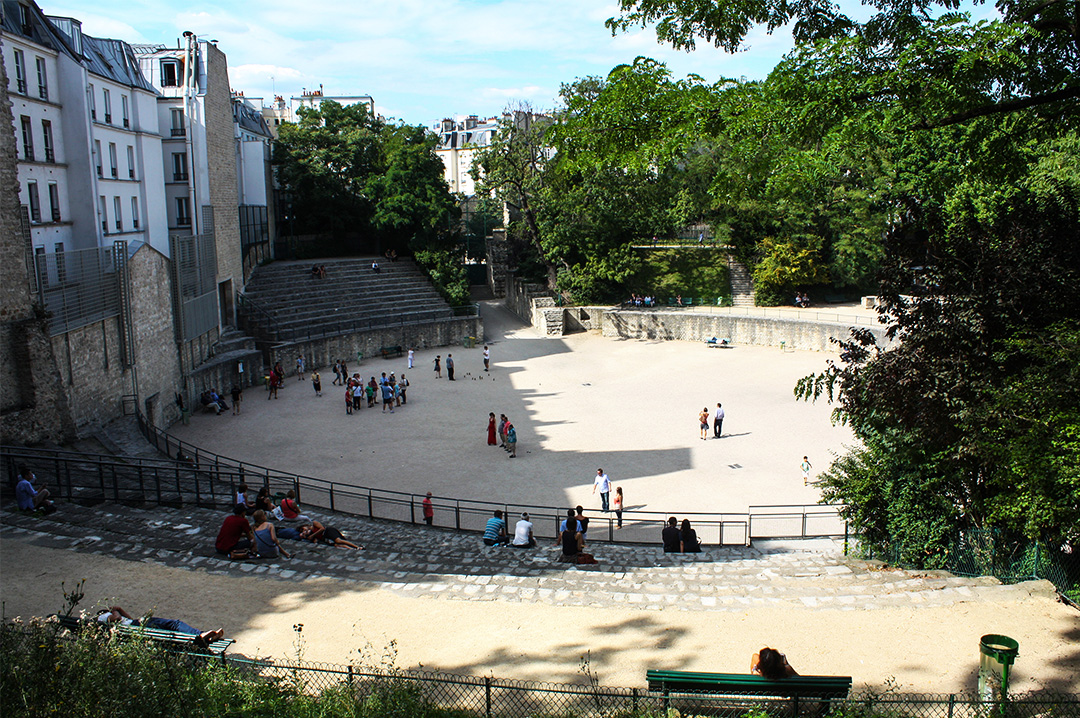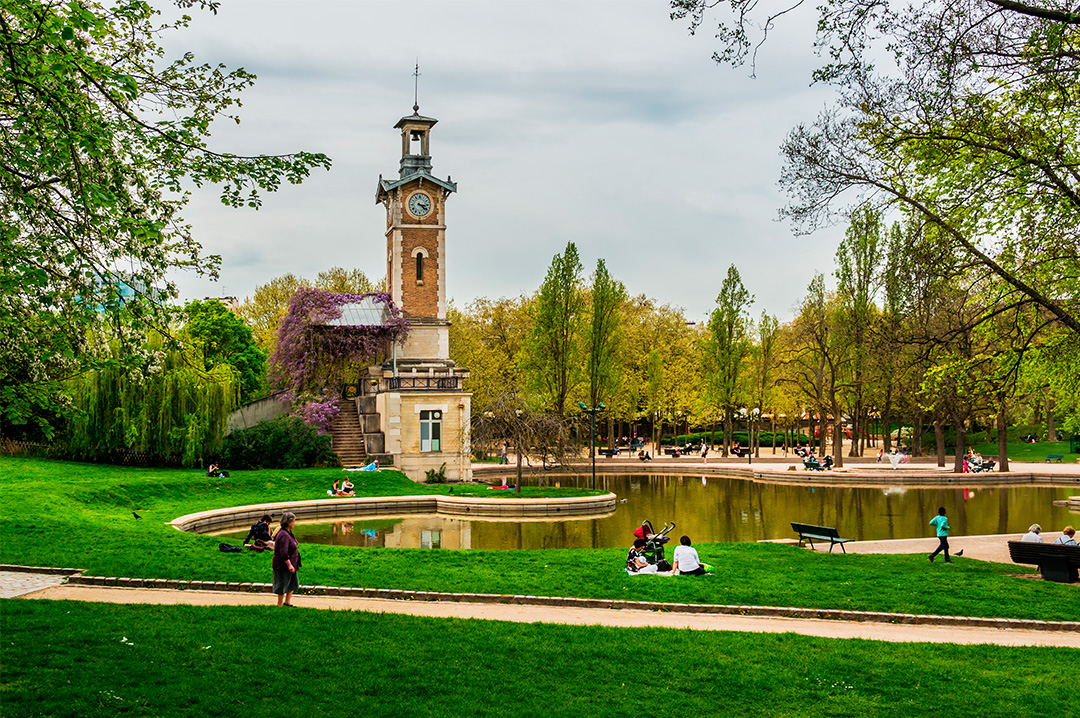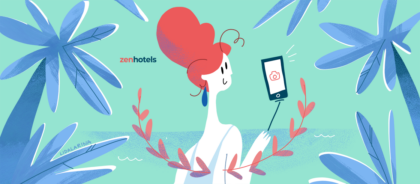Embankments and canals
Beaches are constructed in the central districts of the city: palms in planters align pedestrian routes, some areas are covered with sand or carpeted with roll-out grass, and tables and deck chairs are brought out for picnics. You can spend the entire day here, observing the passers-by, playing table tennis or mini-volleyball; while in the evening you can join free tango lessons or listen to jazz improvisation.
The Right Bank opposite the Île de la Cité hosts many lively summer bars with a basic menu consisting of tapas and barbeque, though some people prefer to feast in their deck chairs or hummocks.
Quai d’Orsay
There are numerous riverside bars on the Left Bank at Quai d’Orsay, between the Musée d’Orsay and Les Invalides. During the day, this place is a skateboarding hang-out: longboarding and skateboarding competitions are held on the pavement marked out with chalk graffiti against a background of reggae music blaring from loudspeakers of the nearby cafes. You can dine in the evening in any of the berthed bars (for example, Bistrot Alexandre III), settle down next to the water behind the long, noisy tables of the local bars, or bring along tapas, oysters, and a glass of rose and dangle your legs right over the Seine.

Quai de Bercy
On warm evenings, crowds of students descend from the halls of the National Library and spread into bars on Quai de Bercy. Bars on barges are particularly popular. Even the students’ canteen sells beer and wine after lunch is over on the top deck. Walking along the river, you will find a bar that tickles your fancy: from open-air with barbeque, basic menus and cheap alcohol (Le Batofar or Petit Bain) to gastropubs drowning in overgrown hanging gardens (La Dame de Canton). There’s even a barge with a swimming pool on deck that sometimes hosts events in the evening.

The four glass high-rise buildings encompassing the library square break up the rays of light at dusk in such a way that the entire space gives the impression of drowning in a reddish glow.
Bercy is home territory for the French youth. Given that trips to the library are an important element of popular culture (you can spend up to three hours queueing for the reading room at weekends!), there are a lot of people on the embankments, in the park and on the library square by the evening. Many see in dusk on the pedestrian bridge — one of the rare locations on the embankment where you can contemplate the setting of the sun right until it descends into the water.
Сanal Saint-Martin
Another favorite place of the locals by the water is Сanal Saint-Martin. In this district, bobo culture is prevalent. Vintage shops and bookstores with selections of rare art books surround the canal. Further, this is a Mecca of trendy fusion cuisine: if you want to hold a picnic, you can buy all sorts of food from the neighboring cafes and restaurants, such as vegan Vietnamese noodles — the best is found in Tieng Hiang, Ethiopian flatbread — we recommend La Reine de Saba, Korean mandu — buy them in Dome, Indian curry — try it at Aux Comptoirs Des Indes, or Algerian shawarma — check out El Mina.

This district is always lively: people snack or sunbathe during the day on the hill in the nearest park, Jardin Villemin, while after sunset they drink noisily in big groups that you can easily join or whom you can ask to borrow a bottle-opener that they found in the street (in fact, walking along the canal you can pick up an entire collection).
Gardens, parks, and squares
Secret gardens are scattered throughout Paris. Many of them are located in locked, private courtyards, which forces lovers of tourist treasures to try and figure out the codes or follow the house owners day and night. Nevertheless, there are a number of secluded locations open to everybody.
These include Jardin des Abbesses by the Wall of Love at Montmartre, which is worth popping into at lunchtime as you try the goodies from the nearby bakery Le Grenier à Pain (one of the best in Paris). There are a lot of these little treasure troves in the district of Le Marais. For example, head for Jardin des Rosiers-Joseph Migneret, which is worth a detour for its famous Rue des Rosiers and where you should try the chef’s special falafel for lunch.
Coulée Verte René-Dumont
Coulée Verte René-Dumont is the jewel in the crown of the 11th arrondissement, linking Le Marais and Bercy. This park promenade extends over four kilometers in length and has an industrial past: during the Second French Empire, it was a railway line leading from Bois de Vincennes to the Bastille. Now, though, you can have lunch here by grabbing a great pizza for five euros from the nearby Pizza le Coq, hide in the bamboo grove and observe Paris in its hustle and bustle from the height of the third floor.

Coulée Verte literally means “green stream.” It begins at the Bastille and runs along the railway line.
Arènes de Lutèce
Another little-known and unusual location for a picnic is Arènes de Lutèce. In the grounds of a truly ancient Parisian building — a Gallo-Roman amphitheater dating to the first century — students and second-hand booksellers of the 5th arrondissement casually take their mid-day meal.

Until the 3rd century AD this arena was used for its stated purpose — for competitions. Shows were also performed here, with the amphitheater accommodating up to 17,000 spectators.
You can purchase food for a picnic — for example, bo bun (a salad with rice noodles and beef) or spring rolls — at the local Thai and Vietnamese cafe, Mekong. It’s well-known for its cheap yet authentic cuisine. Or you can grab some sandwiches or quiche at the nearest bakery, Maison Gaumer, whose doors sported for several years the sign of the best baguette in Paris (an accolade awarded for winning the Grand Prix de la Baguette by La Chambre Professionnelle des Artisans Boulangers du Grand Paris).
A garden or museum of romantic life
Rather than Paris’s closed squares, some people prefer the internal courtyards of museums, where they can relax or take a snack between cultural expeditions. For example, the Musée de la Vie Romantique is famous for its garden with spreading trees, wisterias, and rosebushes. In this quiet courtyard, hidden in the very heart of the lively 9th arrondissement, you can drink fragrant tea (a tea salon takes up part of the territory) or hold a modest picnic.
The Japanese garden at the Guimet Museum
Another beauty hidden from tourists’ eyes is the Japanese garden in the Musée national des arts asiatiques Guimet in the 8th arrondissement. Overgrown bamboo and ivy hide a pavilion where you can spend several hours at an eastern tea ceremony.
Parc des Buttes-Chaumont
Rather than the tourist Meccas that are the gardens of Tuileries and Luxembourg, Parisians prefer parks that are located further away from the famous sights. Their favorites include Parc des Buttes-Chaumont in the north-east of the capital (19th arrondissement). This is a wild English garden covering an area of 25 hectares with a unique geography.

Bridge leading to the Belvedere of Sybil.
A cliff hangs over a huge lake in the middle of the park. On top of the cliff, you will find a belvedere built to resemble the Temple of Vesta in Tivoli. The main part of the park is connected to the artificial island crowned with this “temple” by a bridge built by the great Gustave Eiffel. Thanks to its hilly geography, the garden can compete with the best viewing stations of Paris. Here you can eat a picnic, watch the rays of sunset over Sacre Coeur or feed the ducks and swans on the lake with the left-overs from your baguette. You can also hide in the artificial grotto and pretend to be an English romantic of the early 19th century, or you can swing your legs above the 30-meter drop on the Bridge of Suicides.

Buttes-Chaumont is considered one of the most romantic parks of Europe. You really do get luxurious panoramic views of Paris from here.
Park Batignolles
On the other side of the Basilica of the Sacred Heart in the north-west of Paris, you will come across the miniature Square des Batignolles, created by the same architect who designed Buttes-Chaumont. This park is an interesting synthesis of English and Japanese gardens: here you will find wild exotic growth, little ornate stone bridges, concrete constructions with motifs of nature, artificial ruins, and a small stone garden. A bit of allure is added by a modest waterfall and a lake with black swans and rare duck breeds.
The park is located right in the middle of the 17th arrondissement, and you can buy food for a picnic here on every corner: for example, you can buy real Italian pizza as a takeaway at Mamma Primi, wonderful French crepes at Crêpe-Coeur or simply snack on the freshly-baked cookies at an American dessert shop called Scoop Me a Cookie.
Parc Martin Luther King
Parc Martin Luther King is just across the road from Batignolles. It was opened in 2007 and sports a new type of park architecture that ideally integrates with the industrial space. Locals love it for its secludedness and distance from the noisy center. On any summer day, you will find Parisians sunbathing here during their lunch break. It is split into various zones, including a lake with bulrush and a shaded artificial hill, which enables you to feel secluded at all times. A wonderful flea-market opens here one weekend a month.
Parc Montsouris
Another park rarely frequented by tourists is found at the other end of Paris, in the very south of the capital in the 14th arrondissement. Because Parc Montsouris is situated between the university village and bohemian Montparnasse you can see it in many cult new-wave films such as Cleo from 5 to 7 by Agnès Varda.

Montsouris features inclined lawns and flower beds, rare bushes, and very rich fauna; around 30 species of rare birds live there.
Parc Georges-Brassens
Another pleasant park, Parc Georges-Brassens, is in the south of Paris in the neighboring 15th arrondissement. Previously, there was a village here called Vaugirard, which later gave its name to the longest street in Paris. The park is known for its garden of fragrances with medicinal herbs and spices, and for its rose garden.

A bell-tower stands in the middle of the park surrounded by a pond with a fountain. There is a children’s playground there, artificial cliffs and various attractions.
Parc Georges-Brassens is named after a famous poet and is located beside the famous beehive building (where Soutine, Modigliani, Léger, and Chagall all lived at various times), and it’s no coincidence that second-hand booksellers have come to love the place. On Sundays you can not only set up a picnic and play petanque here, but you can also buy, for example, a prized edition of Diderot for next to nothing.
Squares
The French gladly allow their children to crawl along the dustiest parts of the metropolis, and they will easily dirty their elegant chinos holding a picnic on the side of the road anywhere in the capital.
Place Dauphine
The Parisians love to arrange spontaneous feasts right on dusty squares. One of their favorite playgrounds is Place Dauphine on the Île de la Cité, where they can eat oysters in one of the expensive cafes surrounding the square, or they can snack on a couple of sandwiches sitting right on the ground, watching more elderly residents play petanque.
Place du Pantheon
More democratic choices include Place du Pantheon, which is flowing with students in the afternoon (i.e. those who haven’t gone to study at the national library) or the nearby little square by a church called Saint-Etienne-du-Mont. The best way to feel the various facets of the French capital is to commune with the dust of medieval or renaissance-era squares, sharing lunch with students who have skipped lessons here since the times of Balzac.

Originally, this was the Church of Sainte Genevieve, but now it is the last resting place of France’s greatest offspring: Voltaire, Jean-Jacques Rousseau, Emile Zola, and others are buried here.
When tourists claim that Paris is not what it was, locals reply that the tourists are looking in the wrong place. It’s nonsensical to think that a mime artist in a red beret walking along Montmartre with a baguette under his arm is the embodiment of the French spirit. He’s just as fake as the Roman centurions outside the Colosseum.
Paris isn’t a replica of a Monet painting, and it isn’t a line in a Dassin song. In order to see the real Paris — a modern multicultural and multiethnic capital — you have to travel beyond the borders of the clichéd routes and be ready to see not only the splendeur but also the misères.
Photos: Formosa Wandering, Felix Lipov, theendup, Sebastien DURAND, nikolpetr, Kiev.Victo






